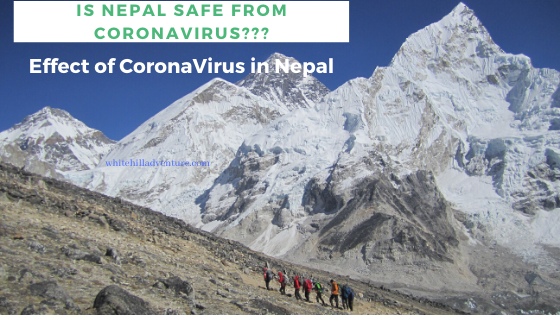
The situation of the coronavirus outbreak in Nepal
In January 2020, the outbreak of the 2019 novel coronavirus in China spread progressively to other countries. With WHO declaring it a Public Health Emergency of International Concern. Among the affected countries beyond China are others in Asia, including Nepal. On Jan 13, 2020, a 32-year-old man, a Nepalese student at Wuhan University of Technology, Wuhan, China, with no history of commodities, returned to Nepal. He presented at the outpatient department of Infectious Disease Hospital, Kathmandu, with a cough.
He had become ill on Jan 3, 6 days before he flew to Nepal. He indicated no exposure to the so-called wet market in Wuhan. On admission to the hospital in Kathmandu, his temperature was 37·2°C (99°F), with throat congestion, but with no other relevant signs or symptoms. He was isolated and treated with broad-spectrum antibiotics and supportive therapies. After 6 hours, he complained of mild breathing difficulty and had decreased oxygen saturation. Chest radiography obtained on admission showed an infiltrate in the upper lobe of the left lung.
On Jan 14, his temperature grows to 38·9°C (102°F) and the next day he had breathing difficulties while in the supine position, with the right lower lung field. His fever was no longer present on Jan 16, and his clinical condition improved. He was discharged the next day and instructed to self-quarantine at home. Laboratory tests showed no abnormalities. Informed consent was obtained from the patient to be included in this Correspondence. Figure initial radiography of the patient View Large Hi-res image Compared with other recently reported cases, which included rapid worsening and even progression to death,1, 2, 5, 6 our patient had only mild disease and survived and recovered after 13 days.
A previous importation of the 2019 coronavirus in a family cluster in Vietnam included a father returning from Wuhan who transmitted the virus to his wife and son. They all recovered in less than 2 weeks. In two cohorts in China, the case fatality rates were 15% and 11%. Some reports have indicated that few patients with 2019 coronavirus infection have prominent upper respiratory tract signs and symptoms, as occurred with the Nepalese student. As expected, fever and cough are the main clinical findings in patients with confirmed 2019 coronavirus infection, with up to a quarter requiring admission to the intensive care unit. Further studies in outpatient, primary care, and community settings are needed to get a full spectrum of clinical severity in imported, secondary cases in all countries.
Chances of being discovered in Nepal
On the back of the outbreak of ‘Coronavirus’ in China, the World Health Organization (WHO) has warned that the virus may also enter Nepal. It exclaimed that Nepal lacks proper healthcare institutes and research laboratories for treatment and diagnosis of highly infectious diseases caused by a coronavirus. Coronavirus is responsible for the outbreak of pneumonia in China, so the movement of people between Nepal and China could spread the deadly virus to Nepal, said the WHO.
Nepal is weak when it comes to global disease outbreaks. With medical service prices rising yearly, people are under the shadow of a slowly lurking problem. Still, the Nepal Government has taken some steps to prevent the transmission of this virus into the country. There are two major institutions involved in the control of the Novel Coronavirus in Nepal- The Sukra raj Tropical and Infectious Disease Control Hospital and Epidemiology and Disease Control Division. They have initiated the screening process on passengers flying in from other countries. Some of the other hospitals assigned by the Nepal Government for this case are Bir Hospital, Civil Hospital, Patan Hospital, and TU Teaching Hospital.
Is Nepal safe from corona
The effect of CoronaVirus in Nepal is not yet seen and the government of Nepal and multiple health organizations and agencies are working on diagnosing and cope with coronavirus. Hopefully, this may work to prevent the spread of coronavirus in Nepal. In this context, Nepal is safe to visit. However, some precautions are necessary just in case. There are not any health emergencies diagnosed with coronavirus in Nepal.
Nepal is safe to visit as the governmental bodies and private sector of Nepal is working on to control this outbreak. Visiting Nepal will not affect your travel experience and of course, Nepal does not have any transmission history of coronavirus till the date. With proper care and precaution, you can travel to Nepal safely.
Due to constant vigilance by government authorities and swift medical response around the world, the spread of the virus has been arrested and well under control globally. The ministry of tourism in Nepal to check and curb the impact of the virus and isolate such cases when reported. A separate health desk manned by doctors and health professionals has been set up at Tribhuvan International Airport as well as in all border points along Nepal and china.
As many as four hospitals are running intensive care units to treat any patients with coronavirus. So far only one confirmed case has been reported in Nepal and the patients with coronavirus. For Nepali citizens, it is best to include some everyday hygienic habits in their daily practices. Our country lacks the facilities for proper treatment and Government support for this outbreak. The only rational thing we can do is share information among peers and family members and help the prevention of coronavirus in Nepal.
Are you looking for a tour and trekking in Nepal? Find here the perfect package for you. Best Deal Guaranteed!
What is coronavirus
Coronaviruses are a large group of viruses that are common among animals. In rare cases, they are what scientists call zoonotic, meaning they can be transmitted from animals to humans, according to the US Centers for Disease Control and Prevention. The viruses can make people sick, usually with a mild to moderate upper respiratory tract illness, similar to a common cold.
Coronavirus symptoms include a runny nose, cough, sore throat, possibly a headache and maybe a fever, which can last for a couple of days. Human coronaviruses are common throughout the world. Seven different coronaviruses, that scientists know of, can infect people and make them sick. Some human coronaviruses were identified many years ago and some have been identified recently. Human coronaviruses commonly cause mild to moderate illness in people worldwide.
Two newer human coronaviruses, MERS-CoV and SARS-CoV, have been known to frequently cause severe illness. Most coronaviruses spread the same way other cold-causing viruses do: through infected people coughing and sneezing, by touching an infected person’s hands or face, or by touching things such as doorknobs that infected people have touched. Almost everyone gets a coronavirus infection at least once in their life, most likely as a young child. In the United States, coronaviruses are more common in the fall and winter, but anyone can come down with a coronavirus infection at any time.
The Generation of Coronavirus
Coronaviruses are common in many different species of animals, including camels and bats. Rarely, these coronaviruses can evolve and infect humans and then spread between humans. Recent examples of this include SARS-CoV and MERS-CoV. Most coronaviruses infect animals, but not people. In the future, one or more of these other coronaviruses could potentially evolve and spread to humans, as has happened in the past.
We still don’t understand why only certain coronaviruses are able to infect people. Coronaviruses primarily infect the upper respiratory and gastrointestinal tract of mammals and birds. They also cause a range of diseases in farm animals and domesticated pets, some of which can be serious and are a threat to the farming industry. In chickens, the infectious bronchitis virus, a coronavirus, targets not only the respiratory tract but also the urogenital tract.
The virus can spread to different organs throughout the chicken. Economically significant coronaviruses of farm animals include porcine coronavirus transmissible gastroenteritis coronavirus and bovine coronavirus, which both result in diarrhea in young animals. Feline coronavirus: two forms, feline enteric coronavirus is a pathogen of minor clinical significance, but spontaneous mutation of this virus can result in feline infectious peritonitis, a disease associated with high mortality. Similarly, there are two types of coronavirus that infect ferrets: ferret enteric coronavirus causes a gastrointestinal syndrome known as epizootic catarrhal enteritis and a more lethal systemic version of the virus known as ferret systemic coronavirus.
There are two types of canine coronavirus, one that causes mild gastrointestinal disease and one that has been found to cause respiratory disease. Mouse hepatitis virus is a coronavirus that causes an epidemic murine illness with high mortality, especially among colonies of laboratory mice. Sialodacryoadenitis virus is a highly infectious coronavirus of laboratory rats, which can be transmitted between individuals by direct contact and indirectly by aerosol. Acute infections have high morbidity and tropism for the salivary, lachrymal and Harderian glands.
How deadly is this
As news of the virus spread and death tolls began to spike, many have begun to question how dangerous the new outbreak is. Coronaviruses, which get their name from their crown-like appearance, come in many types that cause illnesses in people and animals.
Most coronaviruses cause mild symptoms such as the common cold that patients easily recover from. Other strains of the virus such as Severe Acute Respiratory Syndrome and Middle East Respiratory Syndrome can cause pneumonia and possible death. SARS killed 770 of 8,000 people infected in 2002-2003. MERS killed about three or four out of every 10 people infected, the Centers for Disease Control and Prevention said.
In an effort to curb the spread of the disease, the city of Wuhan shut down all air and train traffic to contain it. The World Health Organization (WHO) announced on Jan. 22 it would hold off on declaring a public health emergency of global concern. It is too soon to know how easily the virus will spread. It is airborne and we know it can be transmitted between people.
How it spreads to people and animals
Most often, spread from person-to-person happens among close contacts (about 6 feet). Person-to-person spread is thought to occur mainly via respiratory droplets produced when an infected person coughs or sneezes, similar to how influenza and other respiratory pathogens spread. These droplets can land in the mouths or noses of people who are nearby or possibly be inhaled into the lungs.
It’s currently unclear if a person can get coronavirus by touching a surface or object that has the virus on it and then touching their own mouth, nose, or possibly their eyes. Scientists say transmission of the virus is most likely between people with close contact, like families. But there have been reported instances of people who may have had less exposure to the virus in Japan and Germany.
The coronavirus has now infected more people in China than were sickened there during the 2002-2003 outbreak of SARS. Virologists believe it originated at a seafood market in the eastern Chinese town of Wuhan when someone or a group of people came into contact with wild animals being traded there. Other ways the virus may spread from an infected person to others is through touching or shaking hands, or if a person touches a surface with the virus on it, then touches their mouth, nose, or eyes before washing their hands.
Prevention of CoronaVirus
With recent outbreaks of a new strain of coronavirus reported globally, you may be worried about contracting this illness. Coronavirus is a potentially life-threatening family of viruses that cause conditions like the common cold, MERS, SARS, and other respiratory conditions. While coronavirus can be serious, taking preventative measures can help you protect your health in public, at home, and while caring for a sick person.
If you suspect you have the virus, contact your doctor immediately. Wash your hands with soap and water to minimize your infection risk. The best way to prevent coronavirus is to wash your hands as often as possible. Wet your hands with warm water, then apply a mild soap. Work the soap into a lather for 20-30 seconds, then rinse your hands clean under warm running water. Keep your hands away from your eyes, nose, and mouth. You may come into contact with the coronavirus on a surface, like a doorknob or a countertop.
When this happens, the germs can linger on your hands, so you can easily infect yourself if you touch your face with dirty hands. Avoid touching your eyes, nose, and mouth in case the virus is on your skin. Stay away from people who are coughing or sneezing. Since coronavirus is a respiratory infection, coughing and sneezing are common symptoms. Additionally, coughing and sneezing both release the virus into the air, so they may increase your risk of infection. Keep your distance from people who appear to have symptoms of an upper respiratory infection.
Disinfect high-touch surfaces daily using a product that kills viruses. Unfortunately, coronavirus can linger on surfaces, such as doorknobs, countertops, and faucets. Use a spray disinfectant or bleach wipes to clean these surfaces daily. Make sure the surface stays wet for about 10 minutes so it effectively kills the virus. This limits the risk of the virus lingering on the surfaces and potentially causing an infection.
What is being done to stop this outbreak
The virus has never been seen in humans before and, although the number of people affected is relatively small, it has started to spread more widely. The World Health Organization’s (WHO) emergency committee has declared a global emergency over the new virus. A global emergency is the highest level of alarm the WHO can sound and has previously been used in response to swine flu, Zika virus, and Ebola.
The WHO says it has made coronavirus a global emergency because it is concerned that it could spread to poorer countries that might not have the ability to spot the virus or contain it. By declaring a global emergency, the WHO can support these countries and prepare them for the possibility of cases. The WHO is working closely with global experts and governments to find out more about the virus and try to stop it from spreading further. Some countries have banned travel to and from China to try to contain the virus.
In the UK, extra safety measures are in place at ports and airports, and passengers on flights from affected places are getting extra health checks. There have been eight confirmed cases in the UK so far, and UK citizens in Wuhan are being flown back to Britain to be cared for. The government has said UK people living in China should try to return if they can. But the UK is “extremely well-prepared and used to managing infections”, the government says. It said the patients in the UK found to have symptoms were receiving specialist care, and health experts were “working to prevent the further spread”.
How the effect can be minimized
Symptoms and contact a doctor if they get worse or don’t go away. There is no vaccine for coronavirus. To help prevent a coronavirus infection, do the same things you do to avoid the common cold. You treat a coronavirus infection the same way you treat a cold.
A humidifier or steamy shower can also help ease a sore and scratchy throat. Even when a coronavirus causes MERS or SARS in other countries, the kind of coronavirus infection common in the U.S. isn’t a serious threat for an otherwise healthy adult. If you get sick, treat your symptoms and contact a doctor if they get worse or don’t go away.
And also Wash your hands thoroughly with soap and warm water or with an alcohol-based hand sanitizer. Keep your hands and fingers away from your eyes, nose, and mouth. Avoid close contact with people who are infected.
Is Travel in Nepal Safe from Coronavirus
The effect of CoronaVirus in Nepal is not yet seen and the government of Nepal and multiple health organizations and agencies are working on to diagnose and cope with coronavirus. Hopefully, this may work to prevent the spread of coronavirus in Nepal. In this context, Nepal is safe to visit. However, some precautions are necessary just in case.
There are not any health emergencies diagnosed with coronavirus in Nepal. Nepal is safe to visit as the governmental bodies and private sector of Nepal is working on to control this outbreak. Visiting Nepal will not affect your travel experience and of course, Nepal does not have any transmission history of coronavirus till the date. With proper care and precaution, you can travel to Nepal safely.
Following the spreading rate of the CoronaVirus, the World Health Organization has declared a global health emergency. This alarming situation is the major concern of today’s date however with the statistics available till the date with the infection of Coronavirus in Nepal is negligible and very negative. It will be an epidemic if it enters Nepal as Nepal lacks modern technologies and the necessary equipment in a sufficient amount to diagnose the person with CoronaVirus.
It is said that the virus may transmit the virus without getting any symptoms. In this situation, you might wonder is it a good time to visit Nepal while its neighboring nation itself is suffering from CoronaVirus. It’s very bad that people are suffering in multiple parts of the world. However, in Nepal, as it has negligence chances to spread around with the possible government immediate actions and medical assistance, we can say it’s safe to visit Nepal.
A person who was quarantined and diagnosed with coronavirus is now out of danger with timely medication.
Are you looking for a tour and trekking in Nepal? Find here the perfect package for you. Best Deal Guaranteed!
Work is done by Nepal government to prevent this virus
The Nepali Government is on high alert and has already taken necessary steps to prevent the possible risk of transmission of the virus into the country. The Sukraraj Tropical and Infectious Disease Control Hospital and Epidemiology and Disease Control Division have already initiated health screening of passengers flying in from China, Japan, and Thailand.
A health desk to detect infection of the virus among the inbound tourists is deployed at Tribhuvan International Airport. As of today, three coronavirus infection cases have been reported in Nepal. In view of this, the Nepali Government has assigned the following five hospitals in Kathmandu for the treatment of coronavirus infected patients.
- Sukraraj Tropical & Infectious Disease Hospital
- Bir Hospital
- Civil Hospital
- Patan Hospital
- Tribhuvan University Teaching Hospital
Moreover, the authorities at Tribhuvan International Airport have taken the necessary steps for intensive health screening of passengers from abroad. The government of Nepal has assured all international travelers and tourists that Nepal is safe for travel. And Nepal is continuing its visit Nepal 2020 campaign and has ensured that all the safety mechanisms are in place to contain coronavirus cases and make it safe and sound to travel in nepal.
Initiatives that people can do to stop this
There is currently no vaccine to prevent coronavirus infection. The best way to prevent infection is to avoid being exposed to this virus. However, as a reminder, the CDC always recommends everyday preventive actions to help prevent the spread of respiratory viruses, including. Avoid close contact with people who are sick.
Avoid touching your eyes, nose, and mouth with unwashed hands. Stay home when you are sick. Cover your cough or sneeze with a tissue, then throw the tissue in the trash. Clean and disinfect frequently touched objects and surfaces using a regular household cleaning spray or wipe. Follow CDC’s recommendations for using a facemask. Wash your hands often with soap and water for at least 20 seconds, especially after going to the bathroom; before eating; and after blowing your nose, coughing, or sneezing. If soap and water are not readily available, use an alcohol-based hand sanitizer with at least 60% alcohol.
Always wash hands with soap and water if your hands are visibly dirty. Again, these are all basic protections that should be normal, everyday things. Moorcroft believes that extra protections, like wearing medical masks, aren’t really necessary at this point, unless you have the virus or are being investigated for it. “I’m traveling to LA this weekend and haven’t even thought about wearing a mask,” he says. “As long as people aren’t sneezing, coughing or otherwise depositing their respiratory excretions on you, you should be fine.” On top of basic illness prevention, Moorcroft says the best (and only real) defense against disease is a strong immune system.
Your body is better able to fight off illnesses when your immune system is really humming, he explains, and everyone should put in an effort to get theirs into tip-top shape. To do so, get enough quality sleep at night, stay hydrated, minimize overly processed foods and get enough micronutrients in your diet.






